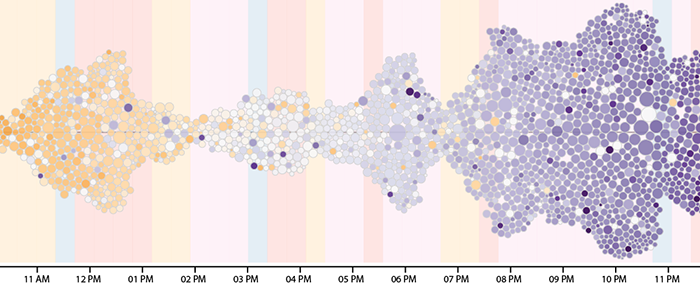I have made my slides, assignments, and in-class examples available for students and other instructors who may be interested. These slides are inspired by many others,…

Contributors:
Jian Zhao, Nan Cao, Zhen Wen, Yale Song, Yu-Ru Lin, and Christopher Collins
We present FluxFlow, an interactive visual analysis system for revealing and analyzing anomalous information spreading in social media. Every day, millions of messages are created, commented on, and shared by people on social media websites, such as Twitter and Facebook. This provides valuable data for researchers and practitioners in many application domains, such as marketing, to inform decision-making. Distilling valuable social signals from the huge crowd’s messages, however, is challenging, due to the heterogeneous and dynamic crowd behaviours. The challenge is rooted in data analysts’ capability of discerning the anomalous information behaviours, such as the spreading of rumours or misinformation, from the rest that are more conventional patterns, such as popular topics and newsworthy events, in a timely fashion. FluxFlow incorporates advanced machine learning algorithms to detect anomalies and offers a set of novel visualization designs for presenting the detected threads for deeper analysis. We evaluated FluxFlow with real datasets containing the Twitter feeds captured during significant events such as Hurricane Sandy. Through quantitative measurements of the algorithmic performance and qualitative interviews with domain experts, the results show that the back-end anomaly detection model is effective in identifying anomalous retweeting threads, and its front-end interactive visualizations are intuitive and useful for analysts to discover insights in data and comprehend the underlying analytical model.
Publications
-
[pods name="publication" id="4359" template="Publication Template (list item)" shortcodes=1]

Contributors:
First language (L1) influence errors are very frequent in English learners (L2), even more so when the learner’s proficiency level is higher (upper-intermediate/advanced). Our project aims to analyze errors made by learners from specific L1’s using learner corpora. Based on the analysis we want to focus on a specific type of error and research a way to identify it automatically in learners’ essays depending on their L1. This would allow us to implement an application that helps English as Second Language (ESL) students to identify and analyze their errors and to better understand the reasoning behind them, consequently improving the students’ English level.
About the EduApps initiative
EduApps is a suite of apps housed in an online environment that focuses on the health, well-being and development of one’s mind, body and community. Our research project titled, “There’s an App for That” is investigating the design process, development, implementation and evaluation of this suite of educational apps. Specifically, we are interested in helping students build confidence and competence in the cognitive, socio-emotional and physical domains. We are also interested in the impact a learning portal can have on students’ learning, teachers and the surrounding community. We hope that our research can build capacity for investigating and affecting innovation in formal and informal education settings in the use of digital technology. We have partnered with school boards and community organizations to develop and research the apps. More about each of the domains — their purpose, apps and related research can be found at http://eduapps.ca/.
Publications
-
[pods name="publication" id="4191" template="Publication Template (list item)" shortcodes=1]


